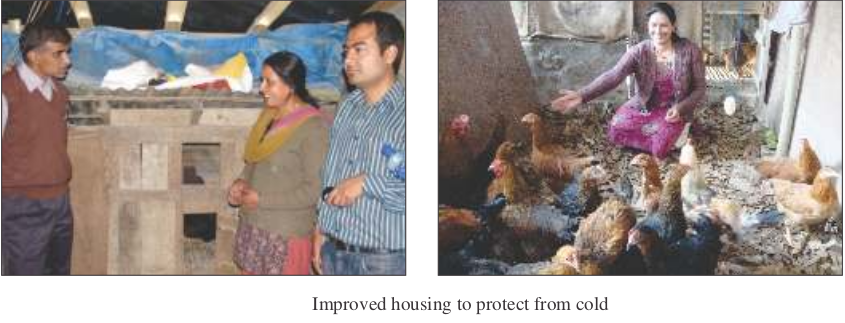Management practices to tackle cold stress in backyard poultry
Management practices to tackle cold stress in backyard poultry
Climate vulnerability
Cold stress
Existing practice
Since time immemorial, villagers in the North Eastern States have been rearing poultry for their livelihood needs. About 10-15 numbers of indigenous fowls were maintained in their backyards for both egg and meat production to generate income and cater to their nutritional needs. However, their productivity is low. Normally chicks scavenge along with hens in open areas. During winter, cold stress affects the backyard poultry especially chicks and causes huge mortality in temperate regions of the country.
Resilient practice / technology
A brooder house was made using locally available materials such as bamboo and wood and to maintain optimum night temperature in the shelter with the help of light bulbs during cold stress period. Breed improvement was made with the introduction of Gramapriya and Vanaraja chicks in NICRA villages. The movement of chicks was restricted nearer the heat source in brooder house with the help of chick guards made with card board. The chicks were fed with ground maize initially, later fed with vegetable wastes and other kinds of locally available grains like maize and rice bran besides the feed material available from free range scavenging as they grew up. Wholesome fresh water was made available at all times in the watering and feeding trough made of bamboo. Chicks were also supplemented with multivitamins @ 1ml /lt of water.
Impact of backyard poultry interventions
A small farmer, Mrs. Pabithra Sharma in Nandok village in East Sikkim was initially supported with a stock of 60 chicks. She sold extra male birds @ Rs. 220/ kg live weight and eggs at the nearby local market and generated a net profit of Rs.11,300 with a benefit cost ratio of 1.78. She purchased 100 more chicks from ICAR Sikkim center and also initiated hatchery with a small capacity of hatching 10-12 eggs at a time by using local broody hens. She could sell the improved breeds to fellow farmers and helped in the horizontal dissemination of these breeds. Now, Nandok village under 26 Naitam Nandok GPU in East Sikkim district has become a hub for backyard poultry production with improved birds. Mrs. Sharma has become a role model for the rural youths and farm women for taking up improved backyard poultry as a potential practice for agri-preneurship development leading to sustainable livelihood security by addressing the climate risk adequately through the improved shelter for chicks and introduction of improved breeds.
Performance of backyard poultry
| Parameters | Performance |
|---|---|
| Mortality up to 10 weeks | <5% |
| Average age at first lay (days) | 145 |
| Average body weight at first lay (Kg) | 2.18 |
| Average annual egg production (No./year) | 178 |
Economics of backyard poultry
| Stock per batch | Expenditure (Rs) | Income (Rs) | Profit (Rs) | B:C ratio |
|---|---|---|---|---|
| 60 | 14446 | 25720 | 11274 | 1.78 |

Scope for upscaling
The practice of rearing backyard poultry with improved synthetics breeds like Gramapriya and Vanaraja by providing proper brooding during early life of chicks and supplementation with grains and vitamins has lot of potential in all the states of NEH region in providing nutritional security and income at household level.
Source: Smart practices and Technologies for Climate Resilient Agriculture
Last Modified : 3/1/2020
This topic provides information about Community ta...
This topic provides information about Check dams f...
This topic provides information about Captive rear...
This topic provides information about Drought tole...
